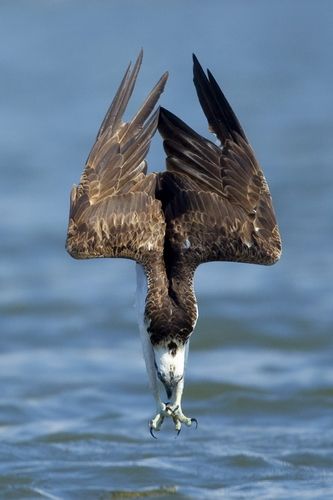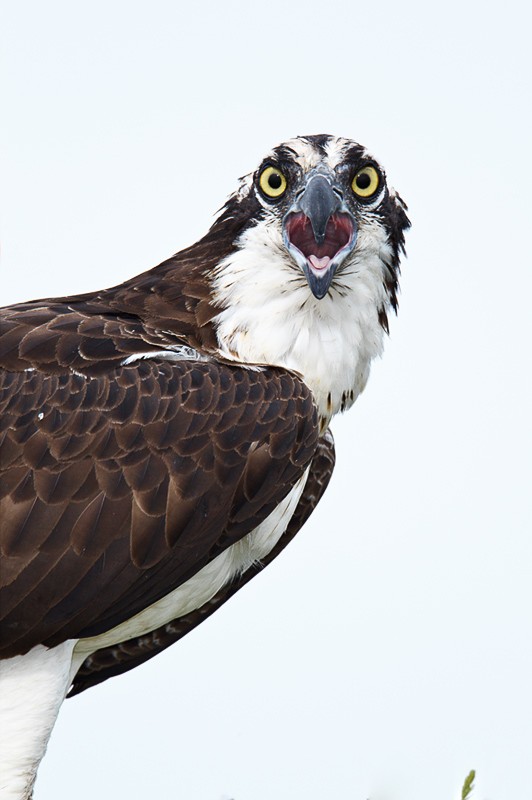Ospreys are awe-inspiring raptors, known for their impressive fishing skills. They live near aquatic environments around the world and Canada is home to around 1/3 of their total population (Bierregaard et.al., 2016). Before the 1970’s, not much was known of the osprey’s life history; not until they began to experience significant population declines did our knowledge of ospreys improve, in an effort to aid their recovery. Since the ban of the organochlorine pesticides such as DDT, their populations have been on the rise, making ospreys great example of a conservation success story (Bierregaard et.al., 2014).
Historical Causes of Decline:
Even before the advent of DDT, there were localized population declines from shootings and collection of their eggs (Bierregaard et.al., 2016). However, from the 1950’s until the use of DDT was banned in North America (in 1972), osprey populations experienced dramatic declines. Birds generally are more susceptible to toxins in the environment, due to their rapid digestive system, and some toxins have the ability to bioaccumulate as they move up the food chain (Wiemeyer et.al., 1975). High levels of DDT in an area can cause the thinning of shells for many birds, but it is especially noticed in raptors, being top predators (Bierregaard et.al., 2014). The presence of DDT in the environment can cause high mortality rates for young and can inhibit adults from reproducing at all in high enough concentrations (Wiemeyer et.al, 1975). The worst part is that it persists within adult ospreys and can impact their ability to lay healthy eggs, even years after exposure to the toxin (Elliot, J.E., 2000).
Strategies for Recovery:
Although we as humans created many of the problems ospreys have faced, it was also the hard work and care of many people that helped stop the use of DDT and have been key in aiding the species to recovery. In many areas, artificial nesting structures have been erected, and this has been one of the most critical aids to their recovery (Bierregaard et.al., 2014). Intensive monitoring and banding projects have also been key to the understanding the resurgence in osprey populations (Bierregaard et.al., 2016).

An osprey chick with a numbered band on it, used to uniquely identify the individual where-ever it goes.
One of the challenges face by recovering osprey populations, is their extirpation from many formerly occupied inland regions. Reintroductions to these areas have been very successful and involve translocating nestlings to artificial nests and supplementing food until they can hunt on their own (Bierregaard et.al., 2016).
The migratory nature of ospreys can also pose challenges to their recovery. For instance, they are still at risk of exposure to toxins like DDT in areas where contamination has resurfaced or where it is not yet banned (Blus et.al., 1987). Additionally, ospreys experience notable mortality due to conflicts with fish farms, especially during migration (Washburn, 2004).
The Good News:
In many locations populations of ospreys have dramatically increased (Watts & Paxton, 2007; Bierregaard et.al., 2014). Our knowledge of their behavior and life history has also greatly increased due to years of research on this species. As its recovery is being monitored all over North America, researchers are beginning to view ospreys as a “sentinel species.” Meaning their health can be used as an indicator for the greater health of aquatic ecosystems, due to their sensitivity to environmental contaminants (Grove et.al., 2009).
Additionally, measures taken for osprey conservation also benefit other organisms within their ecosystems through reducing fishing harvests, conservation of wetlands and better management of water levels in dams. (Bierregaard et.al., 2016).
References:
Bierregaard, R.O., Poole, A.F., Martell, M.S., Pyle, P., Patten, M.A. 2016. Osprey (Pandion haliaetus), version 2.0. In The Birds of North America (P.G. Rodewald, editor). Cornell Lab of Ornithology, Ithaca, New York, USA. Retrieved from: https://doi.org/10.2173/bna.683 .
Bierregaard, R.O., Poole, A.F., Washburn, B.E. 2014. OSPREYS (PANDION HALIAETUS) IN THE 21ST CENTURY: POPULATIONS, MIGRATION, MANAGEMENT, AND RESEARCH PRIORITIES. USDA National Wildlife Research Center – Staff Publications. 48(4): 301 – 307 p. Retrieved from: http://digitalcommons.unl.edu/icwdm_usdanwrc/1476 .
Blus, L.J., Henny, C.J., Strafford, C.J., Grove, R.A. 1987. Persistence of DDT and metabolites in wildlife from Washington state orchards. Arch. Environ. Contam. Toxicol. 16: 467 – 476. Retrieved from: https://link-springer-com.ezproxy.viu.ca/content/pdf/10.1007%2FBF01055269.pdf .
Elliot, J.E., Machmer, M.M., Wilson, L.K., Henny, C.J. 2000. Contaminants in Ospreys from the Pacific Northwest; II. Organochlorine pesticides, polychlorinated biphenyls, and mercury, 1991 – 1997. Arch. Environ. Contam. Toxicol. 38: 93-106 p.
Grove, R.A., Henny, C.J., Kaiser, J.L. 2009. Osprey: worldwide sentinel species for assessing and monitoring environmental contamination in rivers, lakes, reservoirs, and estuaries. J Toxicol Environ Health B Crit Rev. 12(1): 25-44 p. Retrieved from: https://www.ncbi.nlm.nih.gov/pubmed/19117208 .
Washburn, B.E. 2014. Human–Osprey Conflicts: Industry, Utilities, Communication, and Transportation. Journal of Raptor Research. 48(4):387-395 p. Retrieved from: https://doi.org/10.3356/JRR-OSPR-13-04.1 .
Watts, B.D., Paxton, B.J. 2007. Ospreys of the Chesapeake Bay: Population Recovery, Ecological Requirements, and Current Threats. Waterbirds. 30(1):39-49 p.Retrieved from: https://doi.org/10.1675/1524-4695(2007)030[0039:OOTCBP]2.0.CO;2 .
Wiemeyer, S.N., Spitzer, P.R., Krantz, W.C., Lamont, T.G., Cromartie, E. 1975. Effects of environmental pollutatns on Connecticut and Maryland Ospreys. J. Wildl. Manage. 39: 124 – 139 p. Retrieved from: http://www.jstor.org.ezproxy.viu.ca/stable/pdf/3800475.pdf?refreqid=excelsior%3A302f7ccfc71e350418d335c7f36437f2 .






Great post Hannah! It was very informative and I really enjoyed the captions for the pictures, they kept me laughing. I am curious how the artificial nest sites are chosen and if there have been any negative effects because of exposure like in the picture you included? It is great to see that people are taking the initiative to help recreate suitable nesting areas for the Ospreys!
I had a similar question, of how they chose the artificial nesting sites? and what are the parameters are used? How do these artificial nesting sites compare with natural nesting sites? Great post, Hannah!
Hi Nicole & Caitlynn,
Thanks for your questions! As far as I could tell there hasn’t been much research directly indicating a negative impact of artificial nest sites used by ospreys. As I mentioned in one of my posts, there can be issues with the materials ospreys use to build their nests, especially with artificial materials such as twine & materials that can become wrapped around chick’s legs injuring them or preventing them from fledging. In some cases, when ospreys build their nests on buoys or navigation aids for instance, they are not accessible by land mammals and there is reduced chance of predation on the chicks in the nest. One issue with artificial nests however, is that they can be built in areas where humans find them a nuisance (e.g. telephone poles or when navigation aids are blocked) and then the nests have to be removed or hopefully translocated.
I would assume that exposure might pose a risk to the nests, but I need to look into it further. Despite this, artificial nests erected specifically for recovery efforts seem to be working really well & ospreys are increasing their population sizes in many areas.